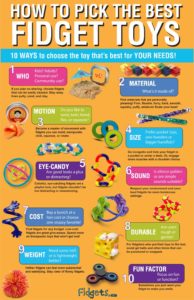Fidget Spinners give fidgeting a bad name!
This past March, 2017, my 13 year-old son told me that we should add these “cool fidget spinners” to our product line.

How to Pick the Best Fidget Toys
In April, we tested a few spinners found one we liked and started selling them online, along with 100s of other vendors! My son even started a mini-business selling the popular toy to his friends (until his school asked him to stop). Since then the Fidget Spinner has gone viral.
Fidget Spinners Banned!
In May, however, schools started banning Fidget Spinners, saying they were distracting and disruptive in class. I have to admit, I’m not surprised. Fidget Spinners are really cool, spinning fast for up to 3 minutes. But, I’m still on the fence about whether they are a fidget toy, or just a toy.
Fidget toys are best when they occupy your hands, not your brain. When they feel good, not look good!
By these tests, the question of whether Fidget Spinner is a toy or a fidget, depends on how you use it. If you spin it by holding it in one hand by a thumb and finger, spin it with the other hand, then sit and watch it, I believe it belongs in the toy category. But, if you quietly rotate it back and forth, in one hand, out of sight and out of mind, then yes, I’d call it a fidget toy.
Fidget Toy vs. Tool
Fidget toys can be extremely effective for kinesthetic learners, folks with ADHD, and others who are easily distracted. One of the reasons they work is because they use up our “floating attention,” that’s the excess attention we’ve been wired with to protect us in the wild. Nowadays, we’re more likely to use these attention reserves to daydream or check a mobile device, not protect ourselves from attack.
When you compare using a fidget toy to using an electronic device during meetings, classes, driving or other situations that require mental focus, it’s easy to understand why the toys are preferable. Not only are they less distracting than the alternative, they can actually help users stay focused.
True fidget toys activate different parts of the brain, than those required for language, communication or cognitive functions. In other words, you should have to think about them at all. Consider, for instance, how difficult it is to talk and read simultaneously. It’s also difficult to rotate one foot counterclockwise and move the other up and down because each of these paired actions uses the same parts of the brain.
So, just because Fidget Spinners might be a little distracting, let’s not rule out the effectiveness of fidgeting in general. If you want to find the perfect fidget toy, you may want to refer to this fidgets infographic (to be posted shortly!), which can help you sort through options based on use, cost, materials, motions, etc.
My recommendation? Keep fidgeting . . . but not with a Fidget Spinner!
- +45
Comments


I teach adults and substitute teach elementary school (K-6). In my adult classes, I actually provide stress balls for students to use while taking quizzes and tests… Many adult students find them helpful. The balls are silent, unobtrusive and I often can’t tell who is actually using them.
II would concur that the test of whether a gadget is a tool or a toy may be found in how it is used. How it is used is, however, often determined by how it is designed. We often must request that children not bring toys to school and if they do bring one, it is typically collected or relegated to the student’s backpack. While I haven’t conducted a study, my observation is that most of the kids who bringing spinners to school are doing so because it’s fashionable and fun. It’s not the “fidgety” kids who are using them. In fact, many kids object to them and find them more than a “little distracting.”
Yes, fidgeting has value, but part of our challenge as teachers is to teach children how to manage their restlessness. We also have an obligation to “protect” our non-fidgeters from distraction. If we do that well, we won’t have issues in our adult classes where cell phone become toys instead of tools. There’s a world of difference between a student (adult or child) squeezing a stress ball and a student texting on his/her smartphone. I’ve never had to confiscate a stress ball, but I have banned cell phones in my adult classes.
I do not think the spinner was designed to help kids focus.It looks like a drone, is best operated with two hands and encourages competition between users. The fact that it has gone viral pretty much makes the point–kids don’t have it to help them focus, they have it because everyone else does and they are fun to play with. This gadget was designed to sell and at that it is succeeding phenomenally.
We need to be very careful that we’re not “teaching” students to multitask while rationalizing that it helps them focus.